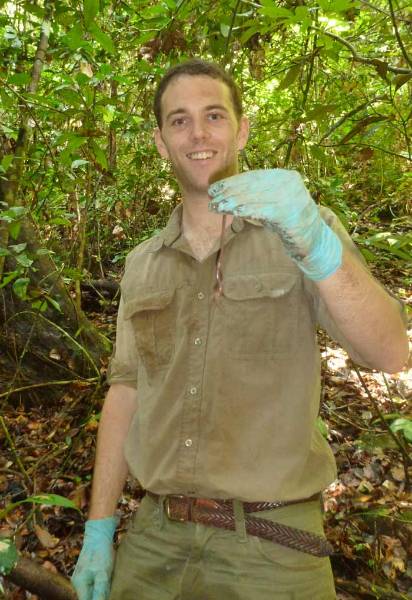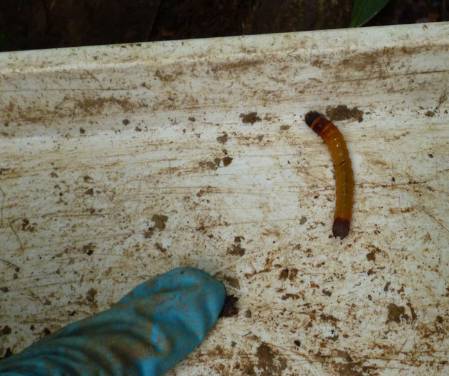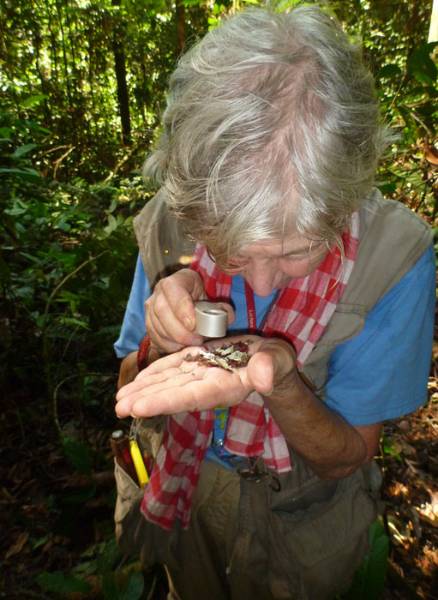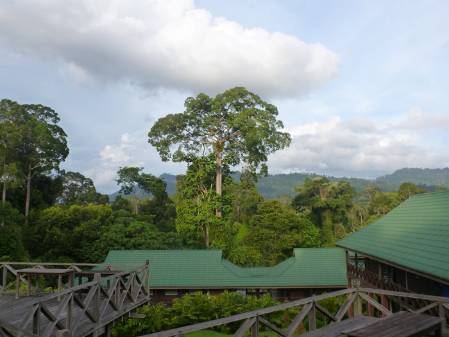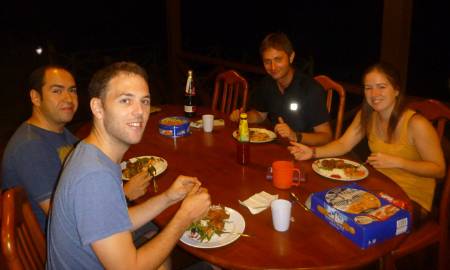Last night we had thunder and lightning, almost directly overhead. It rains most evenings/nights here but last night’s down pour was particularly heavy. Most of us were consequently woken up in the small hours of this morning by the sound of frogs! It sounds like there are hundreds of them surrounding our bunkhouse, although it’s too dark to go out and count, but their constant calling and croaking creates a deafening noise. I will try and get a recording for you to listen to!
Keiron with an earthworm he found in one of the soil samples.
Soil sampling is a simple but effective way of discovering some of the numerous species of invertebrate that are living in the rainforest. Keiron showed me how he digs a hole at set points along the transect line (a line running 100 metres through the site/plot being studied) and then sifts through it looking for animals.
Keiron demonstrates how the team sample the soil in the rainforest.
Dan, Kerry and Keiron have found a variety of animals living in the soil. The majority tend to be ants and termites, which dominate the soil habitat of tropical rainforests, but they’ve also found centipedes, beetle larvae and earthworms (amongst other things).
A large beetle larva found in one of the soil samples. They have sharp jaws so it’s best not to handle them!
Any animals that are found in the soil samples are picked up (using tweezers) and popped into a tube of alcohol. This kills and preserves them (stopping them from decomposing). Some of the ants can move particularly fast, meaning you end up chasing them around the tray with the tweezers….I certainly need to practice more before I’m up to Kerry and Keiron’s standard of tweezer/ant control.
Kerry, with tweezers and tube of alcohol at the ready, carefully studies her soil sample.
Pat, Holger and Kishneth were collecting lichens at the final site today. I had heard that tree diversity in tropical rainforests was high, but I was still surprised when Pat counted up the number of species they have sampled from. Of 84 trees they have sampled, there are 49 different species of tree. And that’s still only a handful of what’s living in the forest here.
Pat explains more about the trees and lichens that she and the lichenologists have been studying.
A good hand lens reveals the colourful and intricate world of lichens on a whole new scale.
Today has been a particularly memorable one because of the ‘monkey action’ we all witnessed this morning taking place in a massive Strangling Fig tree, close to the Studies Centre buildings.
The Strangling Fig tree, viewed from the veranda of the Rest House.
For the best chance of seeing birds and mammals in the rainforest, you want to find a tree that is in flower or fruit. In the last couple of days the figs on this mighty tree have been ripening, and everything is taking advantage of this ready food source!
Yesterday we saw lots of birds, including species of Hornbill, flying into the upper branches. This morning, we caught a quick glimpse of a Bornean Gibbon before it swung swiftly away….which was probably due to the arrival of a troop of Pig-Tailed Macaques. The Macaques managed to get right up into the highest branches, maybe 40 – 50 metres above the ground, and Tony filmed them as they skilfully moved through the branches and seemingly catapulted down the tree!
Despite being so perilously high above the ground, the Macaques are clearly far better adapted to life in the trees than we are!
Needless to say, as sat having dinner this evening (on the veranda outside because it never gets cold here), we all had smiles on our faces following another magical day in the jungle.
Meals of rice, meat and vegetables are supplemented by the odd box of biscuits!



